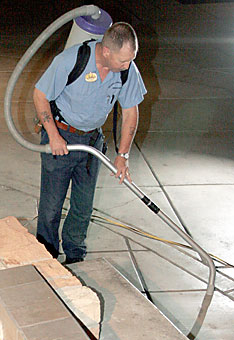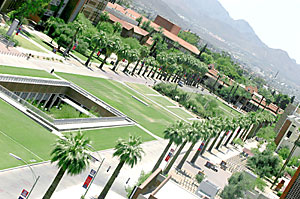By Zach Colick
Arizona Daily Wildcat
Wednesday, June 15, 2005
Print this
Watering lawn with recycled water saves UA; makes lawn vibrant for summer
Over the course of three years, facilities management and a UA Mall panel committee have come up with ways to water the Mall lawn during the hot summer months while ensuring proper conservation of water through the best possible means.
Using the correct water and deciding when to irrigate the lawns is a task that can help save the UA time, money and wasted energy it need not expend if those in charge at the UA's facilities management assume correct and precautious measures.
Located near Campbell and University by the Hillenbrand Aquatic Center, 1827 E. Enke Dr., is a brick building where UA's reclaimed water supply is stored. The water, which comes from the city, provides the UA with water to help irrigate the lawns and flower gardens, including the UA Mall, amongst other irrigateable places surrounding the campus, said Christopher Kopach, associate director for facilities management.
What is reclaimed and potable water?
According to a water resource Web site, (http://www.co.pierce.wa.us/text/abtus/ourorg/pwu/anvsvcs/sewer/reclaim.htm) reclaimed water is wastewater from sewage treatment plants that has been treated further to meet state and federal criteria. In the United States, reclaimed water is used to irrigate parks, golf courses and farmland.
It's not, however, permitted to be used as potable water, or water that is suitable for drinking and free from harmful or objectionable materials.
Pima County's wastewater treatment facility treats wastewater where some of this water is piped into a Tucson water treatment plant.
Treated wastewater is also piped, through more than 100 miles of pipeline and reservoirs, to recharge basins where the recharged water is recovered through wells and mixed with the water produced at the plant. The combined water is then disinfected and delivered to the Tucson metropolitan areas for consumption, according to the facilities management Web site.
How the UA benefits from using reclaimed water
The main supply of reclaimed water is being sprayed on the Mall, on Bear Down Field and the UA football stadium, Kopach said. He said this measure has reduced the amount of potable water being used over the summer months and has helped facilities management to conserve more water than if they were using potable water.
Kopach said facilities management uses a computerized irrigation system, which helps control exact usages of reclaimed water for any area of campus being irrigated, including all flowerbeds and turf areas. Kopach cites the ability to measure specific reclaimed water usage in multiple areas of campus as a huge benefit in using the computerized system.
"We are able to shut down the system immediately if it's wasting water or watering too much in a specific area," Kopach said.
The UA campus also uses reclaimed water for evaporative cooling of campus facilities. With only a small portion of academic, administrative and residence buildings open during summer months, wasted electricity and air conditioning is a concern.
Much like the computerized water- control system, there is also one in place for controlling the air-conditioning and electricity in the buildings surrounding the UA campus.
Kopach said facilities management employs a computerized heating and cooling system that helps to monitor a particular building's usage, which can turn the lights and air conditioning on or off at set times or depending on usage.
"We are definitely saving in electricity use over the summer in our empty buildings," Kopach said.
 |
|
Josh Fields/Arizona Summer Wildcat
|
Lead custodian Mark McGehee vacuums the cracks in the Student Union Memorial Center Monday night. McGehee makes the extra effort to vacuum the sidewalks before powerwashing in order to conserve water.
|
|
|
How the UA uses potable water
Contrarily, potable water is used by the Student Union Memorial Center and Park Student Union for student consumption and in cleaning and maintaining the inside and outside of each building, said Jeff Holt, custodial supervisor at the SUMC.
Holt said custodians try to stay away from using potable water to clean and maintain the SUMC, which more than 20,000 people frequent during the school year, as 80 percent to 90 percent of the buildings can be cleaned by use of a vacuum, broom or an automatic scrubber. The auto scrubbers use a small amount of potable water, which can be recycled for later use, Holt said.
Custodians also maintain the SUMC and PSU by power washing the walls and sidewalks surrounding each building. Power washing is done on an "as needed basis," as vacuuming or sweeping an area can get the job done faster, said David Parker, associate director for operations of Arizona Student Unions.
Parker said power washing uses less water than people think, as only a small amount of potable water is released out of the small pressure-filled hole, cleaning the exterior walls and eating areas adjacent to the SUMC.
Potable water is used rather than reclaimed water to help ensure the safety and health of people who eat outside the SUMC, Holt said. He said he would like to use the recyclable reclaimed water for these cleaning processes but said, "Biologically it wouldn't be a wise idea."
The conservation of electricity is another money-saving tool the SUMC tries to follow as automated systems running on timers help pinpoint how much electricity is being used.
"We definitely make an effort to make our usage as little as possible for both business and economical reasons," Parker said.
What reclaimed water provides and a short history
According to the water resource Web site, wastewater utilities around the country have been reaping the benefits of reclaimed water for more than ten years as drought-stricken regions in California and Arizona have used reclaimed water for industrial processes and to irrigate golf courses, nurseries, and parks.
"Just as recycling newspapers, glass and aluminum makes efficient use of our natural resources, recycling wastewater is a practical way to manage the very valuable and limited resource that is water," Kopach said.
Reclaimed water can be stored underground by allowing water to filter into the water table, or aquifer. This process is referred to as recharging the aquifer, according to the water resource Web site.
Recharged water acts as a savings account during periods of low demand where water can be stored underground. Contrarily, at peak demand in the summer, reclaimed water can be used for purposes such as irrigation, which reduces the demand on drinking water supply.
Reclaimed water enlivens the Mall lawn, at least for a few months
Over the course of three years, facilities management and a UA Mall panel committee have come up with ways in deciding how to water the Mall lawn during the hot summer months in utilizing the best ways possible to ensure proper conservation of water, at the same time.
Both facilities management and the UA Mall committee decided on installing a bermuda sod material beginning in the middle of May when the school year ends. With constant watering over a two-week period, ending around the start of June, facilities management can ensure healthy, green grass over the course of the summer with continuous watering so "the sod can take hold."
Administration and students debate over the feasibility of year-round green grass; lasting impressions of UA
But when students return to campus in the fall, they see green grass for around a month's time before it loses its color and thickness, something that has been called to attention by facilities management.
"The grass is going dormant from October to April and it isn't growing," said Kopach, adding that facilities management doesn't install a winter rye sod to replace the summer sod that begins to lose its luster and thickness towards the end of the fall semester. "Our cooler weather comes in October and doesn't need extra watering."
Sean Whitaker, a communications junior, said it would be nice to see green grass when everyone comes back to school and not just during the summer months when orientation students visit campus, giving them a false impression on what the Mall really looks like year-round.
But Whitaker said he realized the costs and time it would take to maintain such a spacious lawn and said a more desert landscape would be beneficial and cost efficient for the UA and facilities management.
"This is Arizona and people expect the desert. Why try and change the image," Whitaker said.
 |
|
JACOB KONST/Arizona Summer Wildcat
|
The UA uses reclaimed water to keep the mall green and conserve potable water. Reclaimed water is also used to water flowerbeds and turf areas on campus.
|
|
|
Some students around campus this summer think otherwise.
Marino Artea, an animal sciences senior, said the UA wouldn't be wasting water if they used the same reclaimed water and decided to irrigate the Mall grass year-round to make the campus more aesthetically pleasing.
"Having green grass year-round adds some type of value to the university experience in being a student," Artea said.
Artea said facilities management should combine both the arid desert environment along with a more fertile environment that would include more grass in creating a better sense of symmetry.
Asked about installing a winter sod to make the Mall look more aesthetically pleasing over the course of the school year, Kopach responded, "We'll look into that."
Albert D. Tarcola, director of facilities management, said while families choose a higher institution of learning based on their first impressions of the school, he believes making the grass on the Mall green year-round isn't worth the costs and hard work to maintain, despite what some students and parents may think otherwise.
"Bermuda grass is more hearty and is natural to the desert, so it's cheaper, whereas the winter rye sod you would have to cut and water twice as much during the winter months," Tarcola said.
The future of a fertile, grassy look on campus
Tarcola said facilities management is trying to eliminate grass on campus and instead try for a "desertscape" look with more desert Continued from page 12
plants, rocks and trees, to get away from wasting water.
"We have less lawn on campus than we've ever had. We're very cognizant of what we put in the ground to make sure we don't waste water," Tarcola said.
Kopach said the next project in using reclaimed water to irrigate UA lawns is set for the west side of campus including grassy areas located by Old Main and the Arizona State Museum.
Classifying reclaimed water
According to the water resource Web site, a guidelines group decides on a class system for reclaimed water. The water is classified into four separate classes from "A" to "D," in descending order of water quality where the classification is based on the intended use for the reclaimed water. Class "A" designations are the highest quality reclaimed water resource and has the least restrictive uses.
Class "A" reclaimed water must undergo treatment processes in addition to those required for discharged wastewater, including chemical removal of pollutants, filtration and disinfections. This is the same treatment process drinking water plants use to produce tap water, according to the water resource Web site.
Tarcola said the UA gets the cleanest of any reclaimed water since they use part of that water as treated water, which is chilled and stored in a tower to help air condition the buildings around campus.
By using more reclaimed water, Tarcola said the UA has decreased its use of groundwater from the city in sustaining a more ample amount of drinking water. That groundwater is stored in five wells around campus and is used for sanitary purposes and sterilization, besides drinking water.
"Reclaimed water is recycled water, so in effect, you're saving a natural resource," Tarcola said. "(Using reclaimed water) is an environmentally good thing we have to do. We're being a good neighbor."
